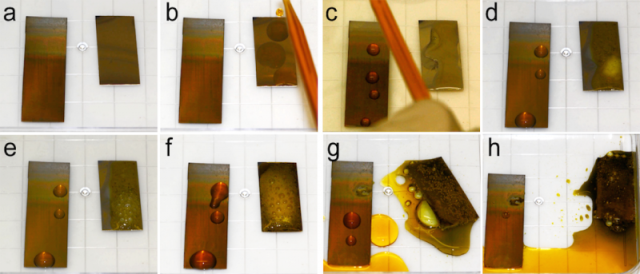Researchers at the Harvard John A. Paulson School of Engineering and Applied Sciences (SEAS) have developed a new nanoporous surface coating that increases the safety, strength, and durability of ubiquitous steel.
 Accelerated corrosion test, in which unmodified stainless steel (300 grade) (right sample)and the lower part of the TO-SLIPS sample with a 600-nm-thick porous TO film on steel (left sample)were exposed to very corrosive Glyceregia stainless steel etchant. (a-h) Images show corrosion evolution as a function of contact time.
Accelerated corrosion test, in which unmodified stainless steel (300 grade) (right sample)and the lower part of the TO-SLIPS sample with a 600-nm-thick porous TO film on steel (left sample)were exposed to very corrosive Glyceregia stainless steel etchant. (a-h) Images show corrosion evolution as a function of contact time.
Over the years, the industry has developed different grades of steel. However, no significant change or improvement has been carried out on steel surfaces. The steel currently being used continues to be affected by abrasive materials and corrosion due to salt and water. Steel surgical tools are still not totally immune to infectious microorganisms.
The research team developed the new surface coating using rough nanoporous tungsten oxide. According to the researchers, this coating is considered to be the most durable anti-corrosive and anti-fouling material able to repel any type of liquid, even after being subjected to severe structural abuse.
Joanna Aizenberg’s lab at Harvard has developed numerous other anti-fouling, non-stick materials. Aizenberg is the Amy Smith Berylson Professor of Materials Science and core faculty member of the Wyss Institute for Biologically Inspired Engineering at Harvard University.
In 2011, Aizenberg’s team developed Slippery Liquid-Infused Porous Surfaces (SLIPS), a coating that has since been used for a wide range of applications. In the present study, the team has used SLIPS to enhance the properties of steel.
“Our slippery steel is orders of magnitude more durable than any anti-fouling material that has been developed before,” said Aizenberg. “So far, these two concepts – mechanical durability and anti-fouling – were at odds with each other. We need surfaces to be textured and porous to impart fouling resistance but rough nanostructured coatings are intrinsically weaker than their bulk analogs. This research shows that careful surface engineering allows the design of a material capable of performing multiple, even conflicting, functions, without performance degradation.”
This material holds promise for a wide range of applications, such as non-fouling medical devices and tools including scalpels and implants, 3D printing nozzles, and marine and building applications.
The team had to find out ways to ensure that the structure of the steel maintained its anti-fouling capability without undergoing any mechanical degradation due to the new surface. The team grew an ultrathin film that was made up of hundreds of thousands of nanoscale rough, tungsten-oxide islands on a steel surface using an electrochemical technique.
“If one part of an island is destroyed, the damage doesn’t propagate to other parts of the surface because of the lack of interconnectivity between neighboring islands,” said Alexander B. Tesler, former postdoctoral fellow at SEAS, current research fellow at Weizmann Institute of Science in Israel and the paper’s first author.
“This island-like morphology combined with the inherent durability and roughness of the tungsten oxide allows the surface to keep its repellent properties in highly abrasive applications, which was impossible until now.”
Aizenberg stated that electrochemical deposition was an established technique used in manufacture of steel.
“I don’t want to create another line that would cost millions and millions of dollars and that no one would adopt,” Aizenberg said. She wanted to create a scalable process that would not affect the standard practices followed by the steel industry.
The material was tested in different ways - by scratching with diamond-tipped scribers, screwdrivers and stainless steel tweezers, and by repeatedly being hit with huge number of heavy, hard beads.
Following this, the material’s anti-wetting properties were tested using various types of liquids, including highly corrosive media, oil, water and biological fluids that contained blood and bacteria. The material demonstrated anti-biofouling behavior and repelled all of the liquid. Additionally, the tungsten oxide coating also enhanced the strength of steel.
Philseok Kim, co-author of the paper and co-founder and vice president of technology at SEAS spin-off SLIPS Technologies Inc., stated that the material holds significant promise for medical steel devices. “Because we show that this material successfully repels bacteria and blood, small medical implants, tools and surgical instruments like scalpels and needles that require both significant mechanical strength and anti-fouling property are high value-added products we are exploring for application and commercialization,” said Kim.
The material also holds considerable promise for functional 3D printing and microarray device applications. It could be very useful for printing highly sticky and viscous polymeric and biological materials, where contamination and friction are significant hindrances.
Every year, the effects of biofouling on hulls have cost the U.S. Navy tens of millions of dollars. Barnacles, algae and other such organisms create drag and increase the amount of energy required. Additionally, significant cost is involved in cleaning the hulls and reapplying anti-fouling paints. If this super-slick material could be scaled up, then it would hold promise as a cost-efficient, clean material.
“This research is an example of hard core, classic material science,” said Aizenberg. “We took a material that changed the world and asked, how can we make it better?”
The study paper on the new SLIPS-enhanced steel has been published in Nature Communications.